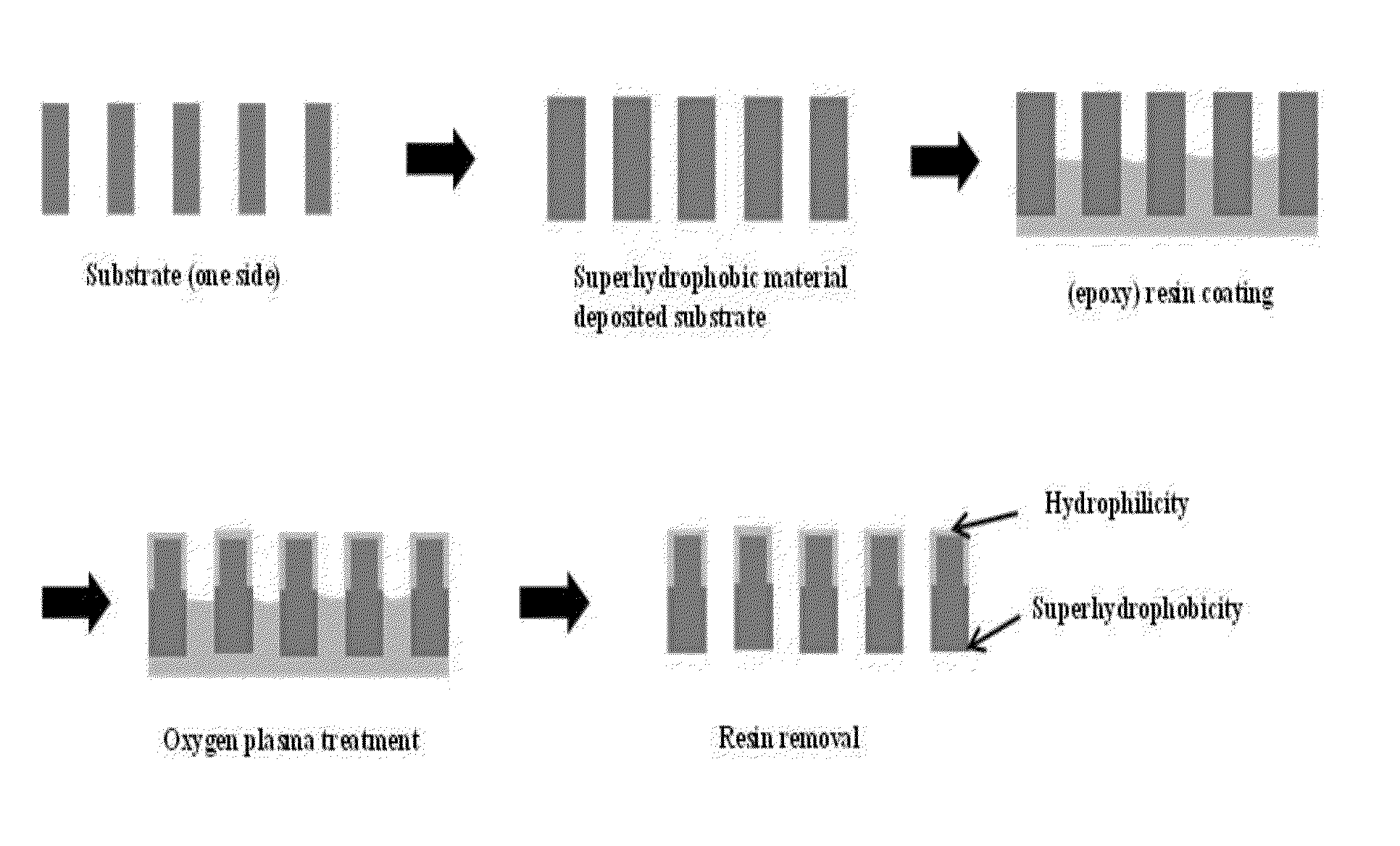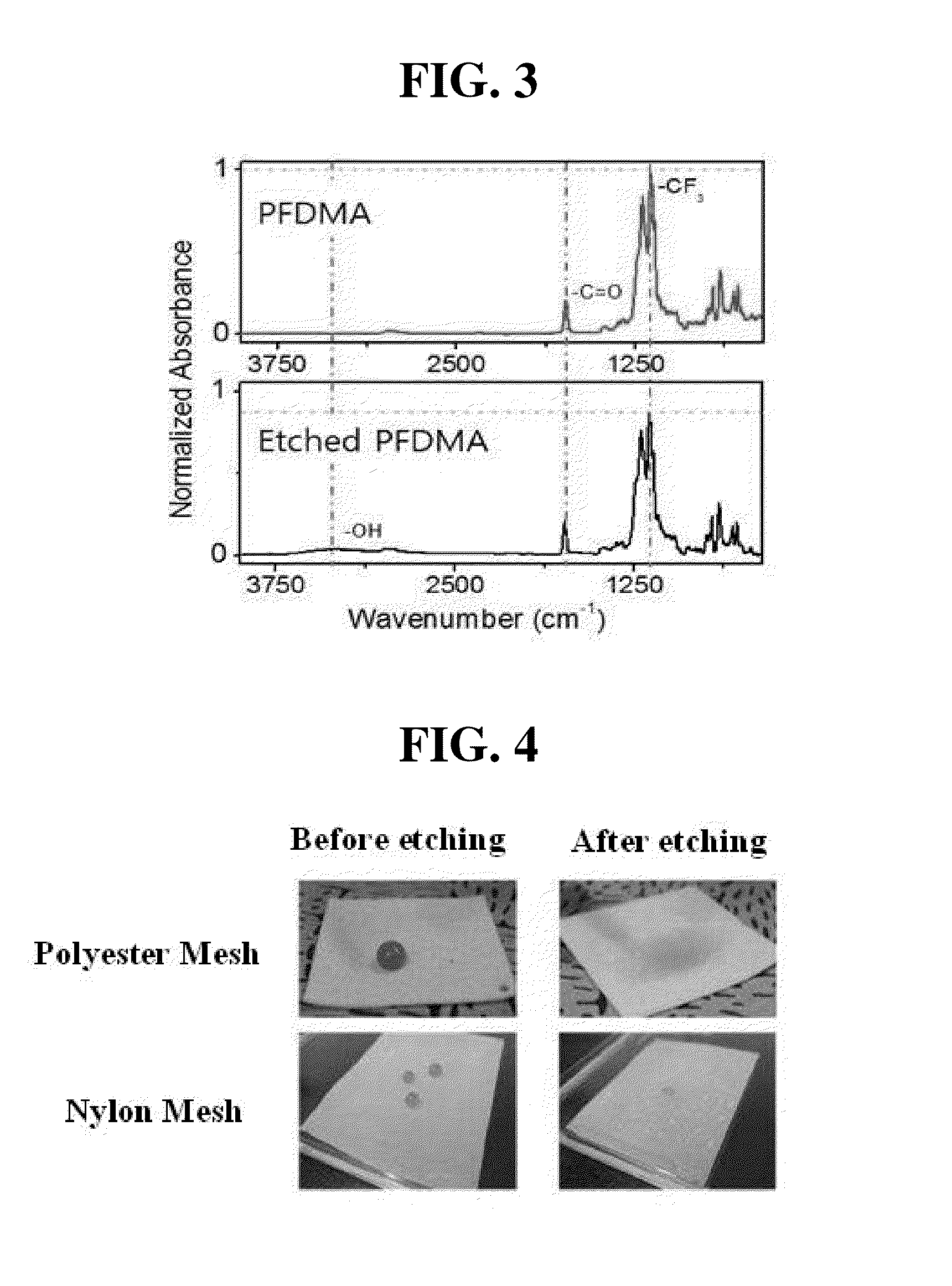Method of fabricating surface body having superhydrophobicity and hydrophilicity and apparatus of preparing the same
a surface body and superhydrophobicity technology, applied in the field of superhydrophobic region and hydrophilicity preparation of surface bodies, can solve the problems of loss of original function, low hydrophobicity, and loss of surface properties of materials
- Summary
- Abstract
- Description
- Claims
- Application Information
AI Technical Summary
Benefits of technology
Problems solved by technology
Method used
Image
Examples
example 1
Preparation of Material Having Superhydrophobic Region and Hydrophilic Region
[0065]As shown in FIG. 1, the monomer PFDMA (3,3,4,4,5,5,6,6,7,7,8,8,9,9,10,10,10-heptadecafluorodecyl methacrylate, Aldrich) was placed in a monomer chamber in an iCVD reactor (Daeki Hi-Tech Co., Ltd.) and heated to 80° C. TBPO (tert-butyl peroxide, Aldrich) as an initiator was placed in an initiator chamber and maintained at room temperature.
[0066]First, deposition was performed using each of a polyester mesh fabric (Puritech PRT-S1091) and a nylon mesh fabric (WW-2030) as a substrate.
[0067]For deposition of PFDMA, PFDMA and TBPO at a ratio of 1:1 were introduced into the iCVD reactor while the temperature of filaments in the reactor was maintained at 200-220° C., the temperature of the substrate in the reactor was maintained at 35-40° C., and preferably 40° C., and the pressure of the chamber in the reactor was maintained at 40-100 mbar. Under such conditions, the deposition of PFDMA was performed for 10...
experimental example 1
Examination of Durability by XPS Analysis
[0069]The material having the superhydrophobic region and the hydrophilic region, prepared using the polyester mesh fabric as the substrate in Example 1, was analyzed by XPS (X-ray photoelectron spectroscopy) (Multilab 2000, Thermo) before and after hydrolysis to examine the ratio of elements present on the surface. The results of the analysis are shown in FIG. 2.
[0070]As a result, it could be seen that the surface of the material prepared in Example 1 was free of a fluoro group after hydrolysis.
experimental example 2
Analysis of Functional Group by FT-IR
[0071]The material having the superhydrophobic region and the hydrophilic region, prepared using the polyester mesh fabric as the substrate in Example 1, was analyzed by FTIR spectrometry (ALPHA FTIR Spectrometer, BRUKER). The results of the analysis are shown in FIG. 3.
[0072]As can be seen in FIG. 3, in the case of the etched PFDMA, —CF3 at a position of 1250 cm−1 decreased, and —OH appeared between 3200 cm−1 and 3400 cm−1 while carboxylic acid was formed due to separation of the fluoro chain from the ester group.
PUM
| Property | Measurement | Unit |
|---|---|---|
| temperature | aaaaa | aaaaa |
| boiling point | aaaaa | aaaaa |
| temperature | aaaaa | aaaaa |
Abstract
Description
Claims
Application Information
 Login to View More
Login to View More - R&D
- Intellectual Property
- Life Sciences
- Materials
- Tech Scout
- Unparalleled Data Quality
- Higher Quality Content
- 60% Fewer Hallucinations
Browse by: Latest US Patents, China's latest patents, Technical Efficacy Thesaurus, Application Domain, Technology Topic, Popular Technical Reports.
© 2025 PatSnap. All rights reserved.Legal|Privacy policy|Modern Slavery Act Transparency Statement|Sitemap|About US| Contact US: help@patsnap.com



